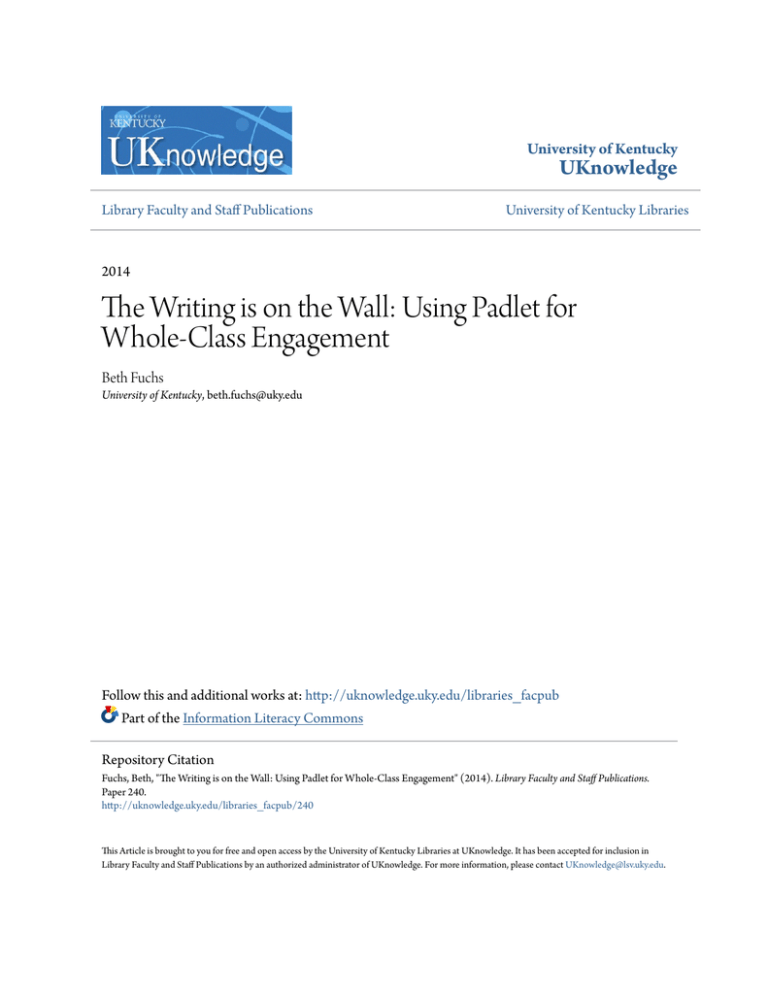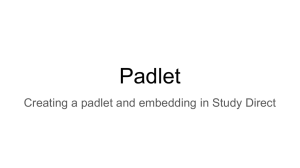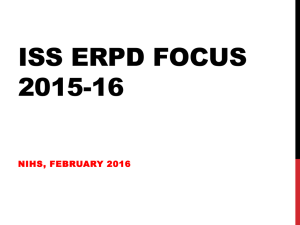The Writing is on the Wall: Using Padlet for Whole
advertisement

University of Kentucky UKnowledge Library Faculty and Staff Publications University of Kentucky Libraries 2014 The Writing is on the Wall: Using Padlet for Whole-Class Engagement Beth Fuchs University of Kentucky, beth.fuchs@uky.edu Follow this and additional works at: http://uknowledge.uky.edu/libraries_facpub Part of the Information Literacy Commons Repository Citation Fuchs, Beth, "The Writing is on the Wall: Using Padlet for Whole-Class Engagement" (2014). Library Faculty and Staff Publications. Paper 240. http://uknowledge.uky.edu/libraries_facpub/240 This Article is brought to you for free and open access by the University of Kentucky Libraries at UKnowledge. It has been accepted for inclusion in Library Faculty and Staff Publications by an authorized administrator of UKnowledge. For more information, please contact UKnowledge@lsv.uky.edu. Number 4 LOEX Quarterly The Writing is on the Wall: Using Padlet for Whole-Class Engagement Beth Fuchs, University of Kentucky When we create opportunities in our library instruction sessions for participatory learning through active learning techniques based on collaboration and peer learning, we do so because we believe some things about creating the best environment for learning. Raymond C. Jones (2008), teacher and educational researcher, articulates four central beliefs held by educators regarding the importance of student participation in the classroom. Those core tenets are: Students should share, rather than withhold, their insights... Students should give evidence of their active and contextual thinking...Students should examine their beliefs and expose them to critical review by others...Students must find and use their voice as emerging professionals. (p. 62) Many of us define success in the classroom by the quality and quantity of student participation, but despite our best efforts, there are substantial barriers in place that discourage students outside of the vocal minority from getting more involved in our classes. This paper describes the use of a "graffiti wall" as found on Padlet (padlet.com) to overcome some of the challenges involved in class participation in order to encourage whole-class collaboration and engagement. Barriers to Participation As instruction has moved from instructor-dominated to student-centered, the importance of class participation has grown. It is now understood that the student experience in the classroom should involve asking questions, participating in discussions and activities, and offering opinions. Students who do not exhibit these behaviors might be perceived to be unprepared, disinterested, hostile, lazy, or bored. The primary reasons for reluctance to contribute to class activities, however, are often much more complex. Stephanie Vandrick (2000) argues from the perspective of a teacher of English as a Second Language (ESL) that many ESL and non-ESL students do not participate in class because they do not feel entitled to do so, meaning that they feel like they lack power. Students who feel powerless in a classroom are more likely to be silent, and if class participation is defined as speaking, the students who feel like they have power already have a significant advantage (p. 3). Vandrick argues that ESL students, women, and students from working-class backgrounds are particularly at risk of not participating in class (p. 4). Class participation, then, can be seen through the lens of culture, gender, class, and race. The ideas of information privilege and critical information literacy are very much at work here. In addition, students can possess a variety of conflicting feelings and beliefs that may discourage them from participating in class. Students may be afraid to make a mistake, afraid that they will not be understood, or afraid of how the instructor or classmates might respond to an opinion that is not widely held. They may feel like their thoughts and opinions are not yet well-formed and thus unworthy to be made public. Students might even feel that speaking up in class, particularly when their thoughts run counter to those of the instructor, would be disrespectful of the classroom authority figure. Some may be learning how to discuss an issue as a group in a formal setting and may be unsure of the unspoken rules of academic discussions. Students may also be shy or fear speaking in public. In the case of the once-and-done information literacy session, students are introduced to a new class facilitator who likely has a very different style and approach to classroom involvement than does the regular instructor. Students are sizing us up to determine what kind of participation we are looking for and how much it deviates from the regular classroom flow. It is risky to interact with a class facilitator, and students may be uncomfortable deviating too much from classroom behavior norms established by the regular instructor. In short, the barriers preventing student participation in class are high, and the incentives for students to participate are low. While we cannot remove all of the barriers, we can continue to seek out ways to support an inclusive classroom environment that welcomes and encourages participation from all. The next section will describe my efforts to do just that by using Padlet walls. Padlet Overview Padlet (www.padlet.com) provides a free, multimediafriendly wall which can be used to encourage real-time, wholeclass participation and assessment. If you have ever led an inclass activity where you have asked students to write ideas on sticky notes and then place their sticky notes on a big piece of paper or wall in order to collect ideas from the whole class, Padlet provides a similar experience online. I have been using it in classes since 2012 when it was known as Wallwisher. Padlet is a useful tool in the information literacy classroom because it works on a variety of different devices, does not require participants to create accounts to use it, and requires no special technical know-how. To use Padlet, go to padlet.com and then click on "Create something." Your wall is now ready for use, but you might want to make some modifications to it, such as giving it a title, changing the background image, giving your wall a unique web address, changing the display of posts, or choosing your wall's level of privacy. Students can contribute to your wall by going to the web address for the wall and then double clicking or, if using a mobile device, touching the wall to open up a box. Within that box, students can type, paste links, add audio or video clips, drag documents, and take pictures with their devices' built-in cameras. Contributions to the wall occur in realtime, so everyone can see when anyone else is adding something to the wall. You have several options for exporting wall contributions, and Padlet embeds very nicely into LibGuides. Page 7 Volume 40 LOEX Quarterly You can create a Padlet account to access walls that you have created, and the content of the walls remains there indefinitely. My experience with Padlet has been only in in-person classes, but it also seems like an ideal tool to use in online classes. As the ACRL Information Literacy Standards are revised to include modes of literacy beyond text, utilizing multimodal technology such as Padlet in instruction will become increasingly important to engage the full spectrum of literacies that are important for information gathering, analysis, use, and creation. Using Padlet in Instruction When I began using Padlet in instruction, I found myself using it in places where I had previously used think-pair-share activities. Rather than posing a question to the class, giving them some time to form their own answers, and then discussing their answers with a classmate before asking for volunteers to share responses, I posted the question on a Padlet wall. Students could then individually add answers to the wall at the same time their classmates were contributing responses, and then I would ask students to get in small groups to analyze the responses from everyone in the class. For example, when introducing first-year students to the differences in search strategies for information in databases compared to information in search engines, I began the class by asking this question in a Padlet wall: "How will you search for your topic? If you had to do a search right now for information on your topic, what would your search look like? Which words would you use, and how would you put them together?" From the responses here, you could see that some students knew about choosing key concepts and connecting them with AND in databases while others typed in phrases (see Figure 1). Seeing the variety of responses allows opportunities for peer learning and self-assessment because students have immediate access to a wide spectrum of responses from classmates rather than a few responses from the vocal ones. I could then use the responses as a method of formative assessment to help determine how best to move forward in instruction to meet student needs. As time went on, I found other ways to use Padlet in class activities. For example, I wanted first-year students to leave the session with an article that they could use, so I asked them to copy and paste the article's permalink to a Padlet site as a "ticket out the door" activity. In a research methods class for history majors, the library instruction session was based on finding primary and secondary sources for their topics, so to determine how well students understood the differences between primary and secondary sources, I asked students to demonstrate their knowledge by providing examples of primary sources associated with a historical event. In a senior level biology class, students were asked to write a short encyclopedia essay about a species of insect, and the professor told me that the students knew how to write long research papers, but writing something concise based on research was a new challenge. To help the students better frame the task before them, I showed an entry from the online encyclopedia that was similar to the type of writing that was required in their assignment. I asked students to read the selection carefully, and once they had finished, I asked this question on a Padlet site: "What kinds of information are found in species overviews? Thought of in another way—if you did a search for Trichoptera and another term to find a piece of the information seen in the overview, what would that other search term be?" Students were able to pick out major concepts and categories of information found in the online selection and use those concepts to help them think about the kinds of information they needed to include in their essays as well as words to use when searching for that information. They were able to rely on each other to lay the foundation for a successful start to the assignment. The professor was particularly pleased that the students' responses on the Padlet site would remain there for future reference. Finally, our firstyear writing classes require that students use and create images and video as part of their research assignments, so for a group research assignment in which group members had decided on their topic shortly before the library session, I asked individual students to find one image that best represents their own understanding of their research topic and post it to a Padlet site. I then had group members convene and talk about the images that they chose in terms of similarities and differences and to come up with keywords associated with their topic. The wide variety of media supported by Padlet provides a particularly rich environment for engaging in today's complex information environment. Risks and Benefits of Real-time Participatory Technology in Class When using technology as a means to encourage wholeclass participation in classroom activities, there are benefits and risks to consider. First and foremost among the benefits is the idea of technology as the great equalizer, particularly when the participant has the option to be anonymous. If students are not confident in their ideas or not sure if they have the right answer, any chance of failure is minimized when no one knows what answer they typed. This realization can allow more freedom and experimentation in the learning process. In addition, students are drawn to the novelty of the technology and seem to want to participate just to have the opportunity to use it. A final benefit of real-time participatory technology is that it can give the teacher a more complete picture of learning from all students, rather than from a handful of the most vocal or most confident ones. The teacher can then use that information to inform lesson development, creating a more targeted and authentic interaction between teacher and students. While the benefits of real-time participatory technology in class are great, its risks are also substantial. First, technology is fickle and unpredictable, as any instruction librarian can already attest to. Internet access comes and goes, and sites go down for maintenance without warning. When you use technology in the classroom, you are at its mercy, and that fact alone may be enough to repel people from using it. With so many unknowns already existing in the classroom, it may seem to some like an act of sheer insanity to knowingly introduce yet another one. Another risk is that real-time means real-time. Students may use the ability to instantaneously see other students' responses as an opportunity to use the technology as a personal stage for silliness. A final risk is that some may per- Page 8 Number 4 LOEX Quarterly ceive the use of new technology in the classroom as educational “smoke and mirrors” and may question its value for teaching. In an effort to be an intentional, purposeful teacher, I consider it important to explain to classes the educational significance associated with activities, so I also make it a point to explain the rationale behind the classroom use of this technology with students. have the ability to contribute and learn from one another. All voices can be heard on a graffiti wall, which is an idea that strikes right at the heart of our profession. References Conclusion Jones, R. C. (2008). The "why" of class participation: A question worth asking. College Teaching, 56(1), 59-63. Retrieved from http://www.tandfonline.com/loi/ vcol20#.U2PoEFdcw60 The challenge of class participation and engagement will remain, so continuing to seek out new ways to encourage involvement from all students will be a necessity. Using Padlet in instruction has provided a non-threatening space for the collection and curation of collaborative classroom work. All students Vandrick, S. (2000, March). Language, culture, class, gender, and class participation. Paper presented at the Annual Meeting of Teachers of English to Speakers of Other Languages, Vancouver, British Columbia, Canada. Figure 1: Student Responses on a Padlet Wall Page 9



